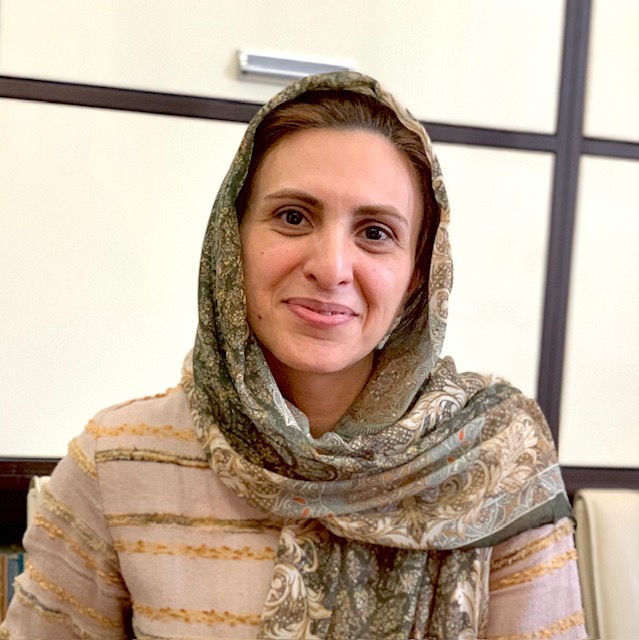1. Arkoun, M. (1994) Islam: To Reform or to Subvert? London: Saqi Books.
2. Ardalan, N. and Bakhtiar, L. (1973) The Sense of Unity: The Sufi Tradition in Persian Architecture. Chicago: University of Chicago Press. https://doi.org/10.1017/S0020743800035005
3. Azarkhsh, M. (2015) Me‘mari-ye masajed-e Iran: Barrasi-ye tarikhi va farhangi Architecture of Iranian mosques: A historical and cultural study]. Tehran: University of Tehran Press.
4. Azmeh, A. (1996) Islamic Fundamentalism: A Critique of the Concept. London: University of London Press. https://doi.org/10.1515/9780691252773
5. Babaie, S. (2008) Isfahan and its Palaces: Statecraft, Shi'ism and the Architecture of Conviviality in Early Modern Iran. Edinburgh: Edinburgh University Press. https://doi.org/10.1515/9780748633760
6. Babaie, S. (2009) Iranian Architecture and the Islamic World. London: I.B. Tauris.
7. Babayan, K. (2002) Mystics, Monarchs, and Messiahs: Cultural Landscapes of Early Modern Iran. Cambridge, MA: Harvard University Press. https://doi.org/10.1017/S0020743805310075
8. Bevir, M. (1999) The Logic of the History of Ideas. Cambridge: Cambridge University Press. https://doi.org/10.1017/CBO9780511490446
9. Blair, S. and Bloom, J. (1995) The Art and Architecture of Islam 1250–1800. New Haven: Yale University Press.
10. Bloom, J., 2007. Arts of the City Victorious: Islamic Art and Architecture in Fatimid North Africa and Egypt. New Haven: Yale University Press.
11. Burke, P. (2015) What is the History of Knowledge? Cambridge: Polity Press.
12. Golombek, L. and Wilber, D. N. (1988) The Timurid Architecture of Iran and Turan. New York: Mazda Publishers.
13. Gottschalk, H. (1998) Philosophy in the Islamic World: A History of Philosophy without any Gaps, Volume 1. Oxford: Oxford University Press.
14. Grabar, O. (1987) The Mediation of Ornament. Princeton: Princeton University Press .https://doi.org/10.1515/9780691252773
15. Grabar, O. (1990) The Mediation of Ornament. Princeton: Princeton University Press. DOI: 10.1515/9780691252773
16. Hillenbrand, R. (1994) Islamic Architecture: Form, Function, and Meaning. Edinburgh: Edinburgh University Press.
17. Hodgson, M.G.S. (1974) The Social Origins of Islamic Architecture. Cambridge: Cambridge University Press. https://doi.org/10.7208/9780226346861.001.0001
18. Hodgson, M.G.S. (1974) The Venture of Islam: Conscience and History in a World Civilization, Vol. 1. Chicago: University of Chicago Press. DOI: 10.7208/ /9780226346861.001.0001
19. Hourani, A. (1991) Arabic Thought in the Liberal Age 1798–1939. Cambridge: Cambridge University Press . https://doi.org/10.1017/CBO9780511801990
20. Haugson, J. (1974) The Social Origins of Islamic Architecture. Cambridge University Press.
21. Jafari, S. (2016) Barrasi-ye kalbadi va ma‘nayi-ye masajed-e tarikhi-ye Iran [A morphological and semantic study of historic Iranian mosques]. Master’s thesis, University of Tehran.
22. Kuban, D. (2018) Muslim Religious Architecture: Development of Religious Architecture in Later Periods. Leiden: Brill.
23. Locke, J. (1980) An Essay Concerning Human Understanding. Edited by P. Nidditch. Oxford: Clarendon Press.
24. Mandlebaum, M. (1965) History of Ideas: An Introduction to Ideological and Intellectual History. New York: Wiley.
25. Memarian, G. (2005) Architecture of Shiraz. Tehran: Iran University Press.
26. McClure, J., 2020. Connected global intellectual history and the decolonisation of the curriculum. History Compass, 18(9), e12634. https://doi.org/10.1111/hic3.12645
27. Nasr, S.H. (1993) Islamic Art and Spirituality. Albany, NY: SUNY Press
28. Nasr, S.H. (2006) ‘Islamic philosophy and spirituality’, The Journal of Islamic Studies, 17(1), pp. 1-23. https://doi.org/10.1093/jis/etj002
29. Necipoğlu, G. (1995) The Topkapı Scroll: Geometry and Ornament in Islamic Architecture. Santa Monica: Getty Publications. https://doi.org/10.1017/S0020743800065661
30. Necipoğlu, G. (2005) The Topkapı Scroll: Geometry and Ornament in Islamic Architecture. Santa Monica: Getty Publications. DOI: 10.1017/S0020743800065661
31. O’Kane, B. (1995) Domes. London: Phaidon Press.
32. Ousterhout, R. (2011) Eastern Medieval Architecture. Oxford: Oxford University Press. https://doi.org/10.1093/oso/9780190272739.001.0001
33. Pope, A. U. (1965) Persian Architecture: The Triumph of Form and Color. New York: George Braziller.
34. Pourjavady, A. (2001) Falsafeh va ‘erfan dar me‘mari-ye eslami-ye Iran [Philosophy and mysticism in Iranian Islamic architecture]. Tehran: Nashr-e Ney.
35. Ricoeur, P. (1976) Interpretation Theory: Discourse and the Surplus of Meaning. Fort Worth, TX: Texas Christian University Press.
36. Sajjadzadeh, M., Rezaei, F. and Karimi, B. (2017) ‘Me‘mari be-masabeh matn: Khaneshi az masajed-e Iran dar bastar-e gofteman-haye fekri’ [Architecture as text: A reading of Iranian mosques in the context of intellectual discourses], Faslnameh-ye Motale‘at-e Me‘mari-ye Eslami (Islamic Architecture Studies Quarterly), 23(4), pp. 57–76.
37. Seyyed Sadegh Haghighat, "History of Ideas, Intellectual History and Political Studies", Research in Theoretical Politics 8, no.14 (2015): 143. magiran.com/p1413467. magiran.com/p1413467
38. Skinner, Q. (1988) The Foundations of Modern Political Thought, Volume 1: The Renaissance. Cambridge: Cambridge University Press.
39. Skinner, Q. (2005) Visions of Politics, Volume 1: Regarding Method. Cambridge: Cambridge University Press. https://doi.org/10.1017/CBO9780511817878
40. Wilber, D. N. (2011) ‘The Safavid Architecture and Urbanism’, in Michell, G. (ed.) Architecture of the Islamic World. London: Thames & Hudson, pp. 200-21.

